Behavior of Alkali-Activated Fly Ash through Underwater Placement
Abstract
:1. Introduction
2. Materials and Methods
2.1. Materials
2.2. Collection of Water Samples
2.3. Specimens Preparation
2.4. Testing and Analysis Methods
3. Results and Discussion
3.1. pH Value and Temperature of Water
3.2. Setting Time
3.3. Compressive Strength
3.4. Chemical Composition Analysis
3.5. Microstructure and Elemental Composition of Reaction Products
4. Conclusions
Author Contributions
Funding
Institutional Review Board Statement
Informed Consent Statement
Conflicts of Interest
References
- Assaad, J.J.; Daou, Y.; Khayat, K.H. Simulation of water pressure on washout of underwater concrete repair. ACI Mater. J. 2009, 106, 1–8. [Google Scholar]
- Yousri, K.M. Self-flowing underwater concrete mixture. Mag. Concr. Res. 2008, 60, 1–10. [Google Scholar] [CrossRef]
- Grzeszcyk, S.; Jurowski, K.; Bosowska, K.; Grzymek, M. The role of nanoparticles in decreased washout of underwater concrete. Constr. Build. Mater. 2019, 203, 670–678. [Google Scholar] [CrossRef]
- Khayat, K.H.; Sonebi, M. Effect of mixture composition on washout resistance of highly flowable underwater concrete. ACI Mater. J. 2001, 98, 289–295. [Google Scholar]
- Jung-Jun, P.; Jae-Heum, M.; Jun-Hyoung, P.; Sung-Wook, K. An estimation on the performance of high fluidity anti-washout underwater concrete. Key Eng. Mater. 2014, 577-578, 501–504. [Google Scholar]
- Sam, X.Y.; Berner, D.E.; Gerwick, B.C. Assessment of Underwater Concrete Technologies for in-the-Wet Construction of Navigation Structure; US Army Corps of Engineers: Washington, DC, USA, 1999. [Google Scholar]
- Heniegal, A.M. Developing underwater concrete properties with and without anti-washout admixtures. Int. J. Sci. Eng. Res. 2017, 7, 97–106. [Google Scholar]
- Wang, J.; Xie, J.; Wang, Y.; Lui, Y.; Ding, Y. Rheological properties, compressive strength, hydration products and microstructure of seawater-mixed cement pastes. Cem. Conc. Comp. 2020, 114, 1–15. [Google Scholar] [CrossRef]
- Mohammed, T.U.; Hamada, H.; Yamaji, T. Performance of seawater-mixed concrete in the tidal environment. Cem Conc. Res. 2004, 34, 593–601. [Google Scholar] [CrossRef]
- Japan Society of Civil Engineers. Recommendations for Design and Construction of Anti-Washout Underwater Concrete. Concr. Libr. JSCE 1992, 19, 1–61. [Google Scholar]
- Zhang, J.; Shi, C.; Zhang, Z.; Ou, Z. Durability of alkali-activated materials in aggressive environments: A review on recent studies. Constr. Build. Mater. 2017, 152, 598–613. [Google Scholar] [CrossRef]
- Mcleod, R.S. Ordinary portland cement with extraordinary high CO2 emission. What can be done to reduce them? BFF Autumn. 2005, 15, 30–33. [Google Scholar]
- Singh, B.; Ishwarya, G.; Gupta, M.; Bhattacharyya, S.K. Geopolymer concrete: A review of some recent developments. Constr. Build. Mater. 2015, 85, 78–90. [Google Scholar] [CrossRef]
- Wardhona, A.; Gunasekara, C.; Law, D.W.; Setunge, S. Comparison of long-term performance between alkali activated slag and fly ash geopolymer concretes. Constr. Build. Mater. 2017, 143, 272–279. [Google Scholar] [CrossRef]
- Rakngan, W.; Williamson, T.; Ferron, R.D.; Sant, G.; Juenger, M.C.G. Controlling workability in alkali-activated class C fly ash. Constr. Build. Mater. 2018, 183, 226–233. [Google Scholar] [CrossRef]
- OECD/IEA. World Energy Outlook 2008; International Energy Agency (IEA) Publications: Paris, France, 2008; p. 578. [Google Scholar]
- Alvarez-Ayuso, E.; Querol, X.; Plana, F.; Alastuey, A.; Moreno, N.; Izquierdo, M.; Font, O.; Moreno, T.; Diez, S.; Vázquez, E.; et al. Environmental, physical, and structural characterisation of geopolymer matrixes synthesised from coal (co-) combustion fly ashes. J. Hazard. Mater. 2008, 154, 175–183. [Google Scholar] [CrossRef] [PubMed]
- Fernandez-Jimenez, A.; de la Torre, A.G.; Palomo, A.; Lopez-Olmo, G.; Alonso, M.M.; Aranda, M.A. G Quantitative determination of phases in the alkali activation of fly ash. Part 1. Potential ash reactivity. Fuel 2006, 85, 625–634. [Google Scholar] [CrossRef]
- Siddique, S.; Jang, J.G. Acid and sulfate resistance of seawater based alkali activated fly ash: A sustainable and durable approach. Constr. Build. Mater. 2021, 281, 122601. [Google Scholar] [CrossRef]
- Ryu, G.S.; Lee, Y.B.; Koh, K.T.; Chung, Y.S. The mechanical properties of fly ash-based geopolymer concrete wit alkaline activators. Constr. Build. Mater 2013, 47, 409–418. [Google Scholar] [CrossRef]
- Rattanasak, U.; Chindaprasirt, P. Influence of NaOH solution on the synthesis of fly ash geopolymer. Miner. Eng. 2009, 22, 1073–1078. [Google Scholar] [CrossRef]
- Mustafa Al Bakri, A.M.; Kamarudin, H.; Khairul Nizam, I.; Bnhussain, M.; Zarina, Y.; Rafiza, A.R. Correlation between Na2SiO3/NaOH ratio and fly ash/alkaline activator ratio to the strength of geopolymer. Adv. Mater. Res. 2012, 341-342, 189–193. [Google Scholar] [CrossRef]
- Palomo, A.; Grutzeck, M.; Blanco, M. Alkali-activated fly ashes. A cement for the future. Cem. Concr. Res. 1999, 29, 1323–1329. [Google Scholar] [CrossRef]
- van Jaarsveld, J.G.S.; van Deventer, J.S.J.; Lukey, G.C. The effect of composition and temperature on the properties of fly-ash and kaolinite-based geopolymers. Chem. Eng. J. 2002, 89, 63–73. [Google Scholar] [CrossRef]
- Abdullah, M.M.A.; Kamarudin, H.; Mohammed, H.; Khairul Nizam, I.; Rafiza, A.R.; Zarina, Y. The relationship of NaOH molarity, Na2SiO3/NaOH ratio, fly ash/alkaline activator ratio, and curing temperature to the strength of fly ash-based geopolymer. Adv. Mater. Res. 2011, 328–330, 1482–1485. [Google Scholar]
- Kupwade-Patil, K.; Allouche, E.N. Examination of chloride-induced corrosion in reinforced geopolymer concretes. J. Mater. Civ. Eng. 2012, 25, 1465–1476. [Google Scholar] [CrossRef]
- Shaikh, F.U. Effects of alkali solutions on corrosion durability of geopolymer concrete. Adv. Concr. Constr. 2014, 2, 109–123. [Google Scholar] [CrossRef] [Green Version]
- Chindaprasirt, P.; Chalee, W. Effect of sodium hydroxide concentration on chloride penetration and steel corrosion of fly ash-based geopolymer concrete under marine site. Constr. Build. Mater. 2014, 63, 303–310. [Google Scholar] [CrossRef]
- Sakkas, K.; Panias, D.; Nomikos, P.P.; Sofianos, A.I. Potassium based geopolymer for passive fire protection of concreter tunnels linings. Tunnel. Under. Space Tech. 2014, 43, 148–156. [Google Scholar] [CrossRef]
- Yun-Ming, L.; Cheng-Yong, H.; Long-Yuan, L.; Jaya, N.A.; Abdullah, M.M.A.; Soo-Jin, T.; Hussin, K. Formation of one-part mixing geopolymers and geopolymer ceramics from geopolymer powder. Constr. Build. Mater. 2017, 156, 9–18. [Google Scholar]
- ASTM C618-12a. Standard specification for coal fly ash and raw or calcined natural pozzolan for use in concrete. In Annual Book of ASTM Standards; ASTM International: West Conshohocken, PA, USA, 2013. [Google Scholar]
- Mustafa Al Bakri, A.M.; Kamarudin, H.; Bnhussain, M.; Khairul Nizar, I.; Rafiza, A.R.; Zarina, Y. Microstructure of different NaOH molarity of fly ash-based green polymeric cement. J. Eng. Tech. Res. 2011, 3, 44–49. [Google Scholar]
- ASTM C191-01. Standard Test Method for Time of Setting of Hydraulic Cement by Vicat Needle; ASTM International: West Conshohocken, PA, USA, 2001. [Google Scholar]
- ASTM C109 / C109M-16a. Standard Test Method for Compressive Strength of Hydraulic Cement Mortars (Using 2-in. or [50-mm] Cube Specimens); ASTM International: West Conshohocken, PA, USA, 2016. [Google Scholar]
- Chindaprasirt, P.; Jaturapitakkul, C.; Chalee, W.; Rattanasak, U. Comparative study on the characteristic of fly ash and bottom ash geopolymers. Waste Mngmnt. 2009, 29, 539–543. [Google Scholar] [CrossRef] [PubMed]
- Weng, L.; Sagoe-Crentsil, K. Dissolution process, hydrolisis and condensation reactions during geopolymer synthesis: Part I—Low Si/Al ratio systems. J. Mater. Sci. 2007, 42, 2997–3006. [Google Scholar] [CrossRef]
- Skvara, F.; Kopecky, L.; Smilauer, V.; Bittnar, Z. Material and structural characterization of alkali activated low-calcium brown coal fly ash. J. Hazard. Mater. 2009, 168, 711–720. [Google Scholar] [CrossRef] [PubMed]
- Rattanasak, U.; Pankhet, K.; Chindaprasirt, P. Effect of chemical admixture on properties of high-calcium fly ash geopolymer. Int. J. Miner. Metal. Mater. 2011, 18, 364–369. [Google Scholar] [CrossRef]
- Mohamed, R.; Abd Razak, R.; Abdullah, M.M.A.B.; Shuib, R.K.; Subaer, C.J. Geopolymerization of class C fly ash:reaction kinetics, microstructure properties and compressive strength of early age. J. Non-Crys. Sol. 2021, 553, 1–15. [Google Scholar] [CrossRef]
- Puligilla, S.; Mondal, P. Role of slag in microstructural development and hardening of fly ash-slag geopolymer. Cem. Concr. Res. 2013, 43, 70–80. [Google Scholar] [CrossRef]
- Yang, S.; Xu, J.; Zang, C.; Li, R.; Yang, Q.; Sun, S. Mechanical properties of alkali-activated slag concrete mixed by seawater and sea sand. Constr. Build. Mater. 2019, 196, 395–410. [Google Scholar] [CrossRef]
- Duxson, P.; Fernandez-Jimenez, A.; Provis, J.L.; Lukey, G.C.; Palomo, A.; van Deventer, J.S.J. Geopolymer technology: The current state of the art. J. Mater. Sci. 2007, 42, 2917–2933. [Google Scholar] [CrossRef]
- Kumar, S.; Kumar, R.; Mehrotra, S.P. Influence of granulated blast furnace slag on the reaction structure and properties of fly ash based geopolymer. J. Mater. Sci. 2010, 45, 607–615. [Google Scholar] [CrossRef]
- De Silva, P.; Sagoe-Crentsil, K.; Sirivivatnanon, V. Kinetics of geopolymerisation: Role of Al2O3 and SiO2. Cem. Conc. Res. 2007, 37, 512–518. [Google Scholar] [CrossRef]
- Weng, L.; Sagoe-Crentsil, K.; Brown, T.; Song, S. Effects of aluminates on the formation of geopolymers. Mater. Sci. Eng. B. 2005, 117, 163–168. [Google Scholar] [CrossRef]
- Perera, D.S.; Cashion, J.D.; Blackford, M.G.; Zhang, Z.; Vance, E.R. Fe specification in geopolymers with Si/Al molar ratio of 2. J. Eur. Ceram. Soc. 2007, 27, 2697–2703. [Google Scholar] [CrossRef]
- Rossano, S.; Behrens, H.; Wilke, M. Advanced analyses of 57Fe Mossbauer data of alumino-silicate glasses. Phys. Chem. Miner. 2008, 35, 77–93. [Google Scholar] [CrossRef]
- Xu, H. Geopolymerisation of Aluminosilicate Minerals. Ph.D. Thesis, University of Melbourne, Melbourne, Australia, 2001. [Google Scholar]
- Van Jaarsveld, J.G.S.; Van Deventer, J.S.J.; Lukey, G.C. The characterisation of source materials in fly ash-based geopolymers. Mater. Lett. 2003, 57, 1272–1280. [Google Scholar] [CrossRef]
- Timakul, P.; Rattanaprasirt, W.; Aungkavattana, P. Improving compressive strength of fly ash-based geopolymer composites by basalt fibers addition. Ceram. Int. 2016, 42, 6288–6295. [Google Scholar] [CrossRef]
- Gani, M.S.J. Cement and Concrete, 1st ed.; Chapman and Hall: London, UK, 1997. [Google Scholar]
- Richardson, I.G. The nature of C-S-H in hardened cements. Cem. Concr. Res. 1999, 29, 1131–1147. [Google Scholar] [CrossRef]
- Xu, H.; van Deventer, J.S.J. The geopolymerisation of aluminosilicate minerals. Int. J. Miner. Process 2000, 59, 247–266. [Google Scholar] [CrossRef] [Green Version]
- Kumar, R.; Kumar, S.; Mehrotra, S.P. Towards sustainable for fly ash through mechanical activation. Resour. Conser. Recycl. 2007, 52, 157–179. [Google Scholar] [CrossRef]
- Yip, C.K.; Lukey, G.C.; van Deventer, J.S.J. The coexistence of geopolymeric gel and calcium silicate hydrate at the early stage of alkali activation. Cem. Concr. Res. 2005, 35, 1688–1697. [Google Scholar] [CrossRef]
- Wang, Y.; He, F.; Wanf, J.; Hu, Q. Comparison of effects of sodium bicarbonate and sodium carbonate on the hydration and properties of Portland cement paste. Materials 2019, 12, 1033. [Google Scholar] [CrossRef] [Green Version]
- Wang, Y.; He, F.; Wang, J.; Wang, C.; Xiong, Z. Effects of calcium bicarbonate on the properties of ordinary Portland cement paste. Constr. Build. Mater. 2019, 225, 591–600. [Google Scholar] [CrossRef]
- Kumar, S.; Djobo, J.N.Y.; Kumar, A.; Kumar, S. Geopolymerization behaviour of fine iron-rich fraction of brown fly ash. J. Build. Eng. 2016, 8, 172–178. [Google Scholar] [CrossRef]
- Nergis, D.D.B.; Vizureanu, P.; Ardelean, I.; Sandu, A.V.; Corbu, O.C.; Matei, E. Revealing the Influence of Microparticles on Geopolymers' Synthesis and Porosity. Materials 2020, 13, 3211. [Google Scholar] [CrossRef] [PubMed]
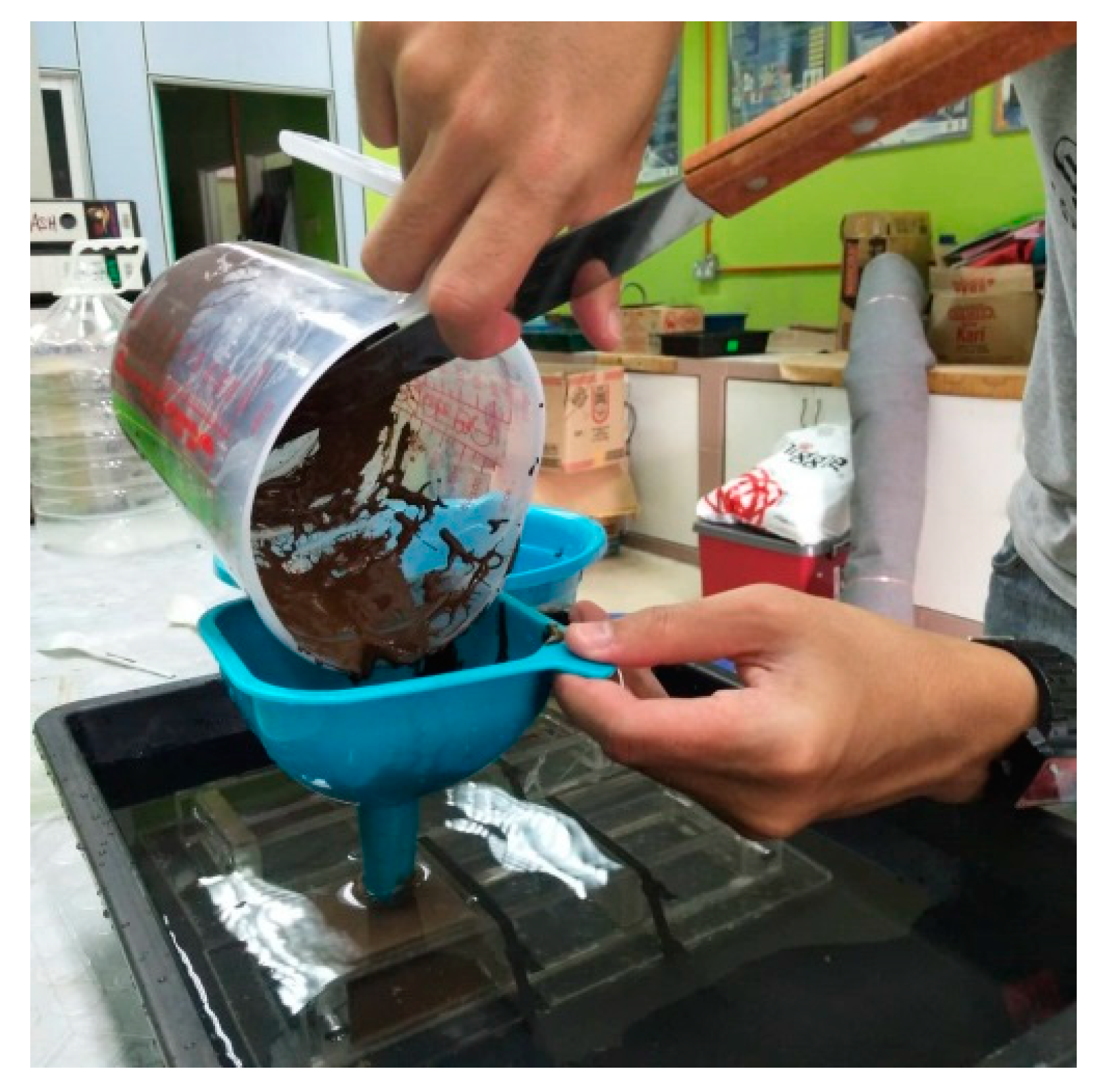

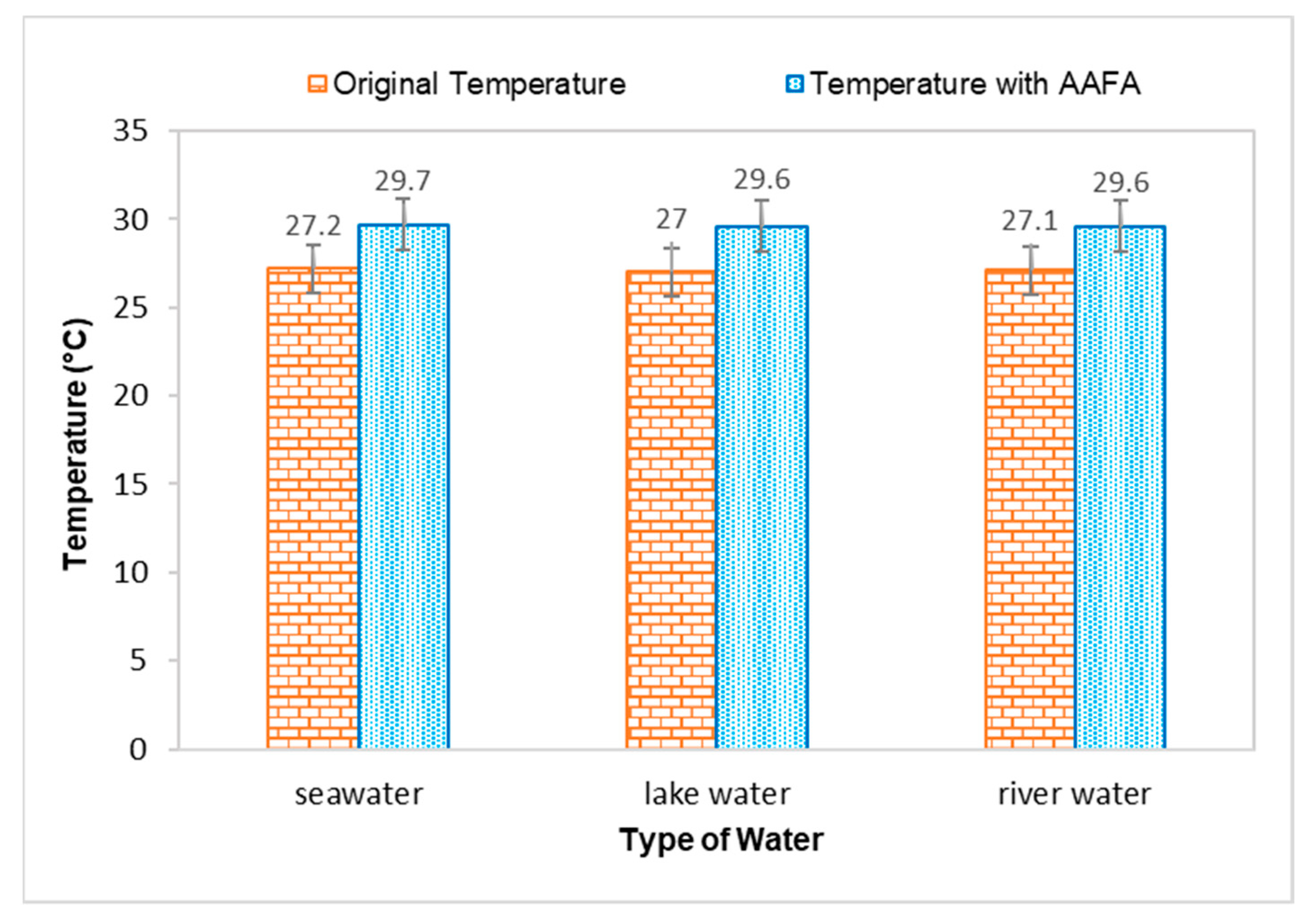
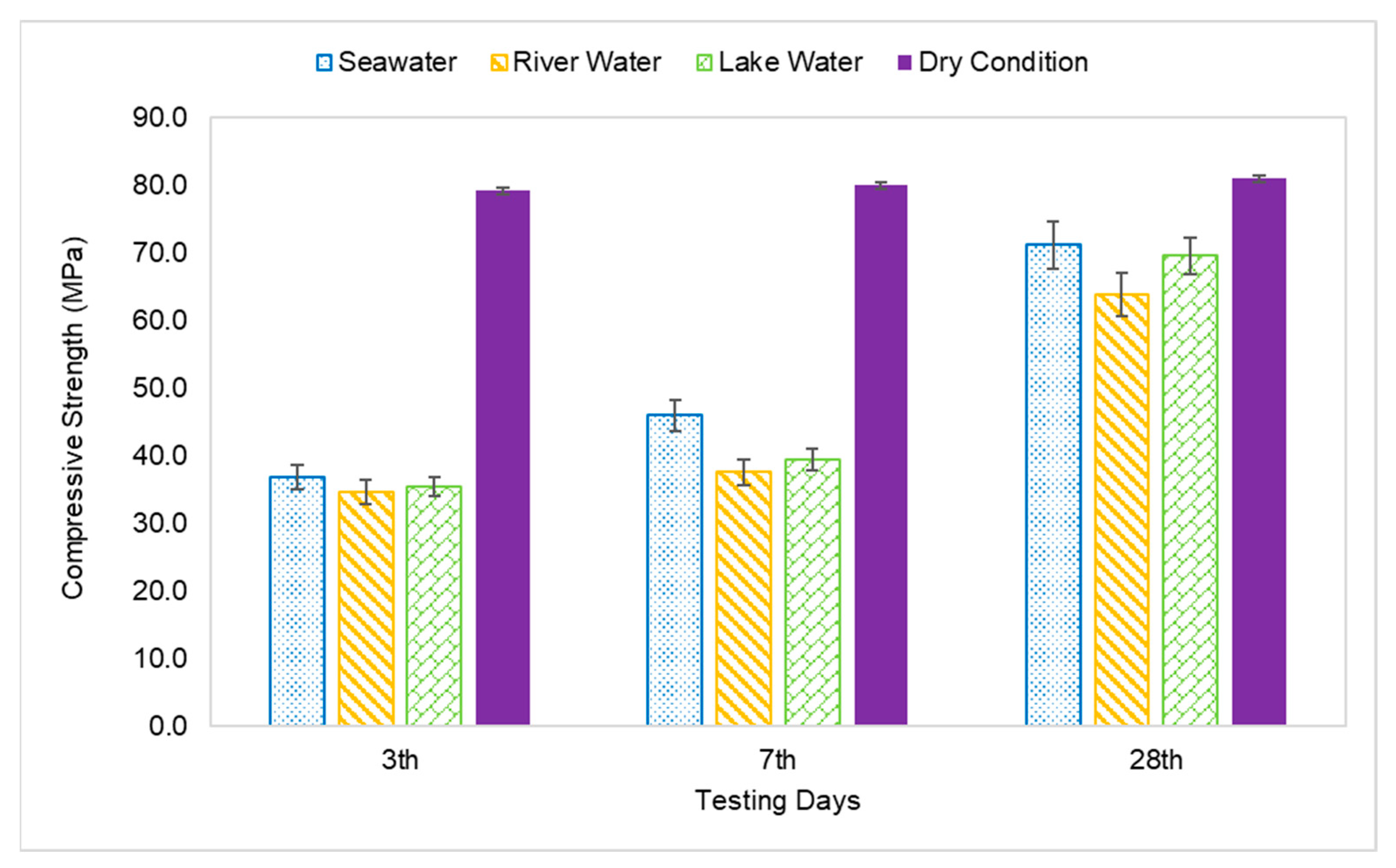
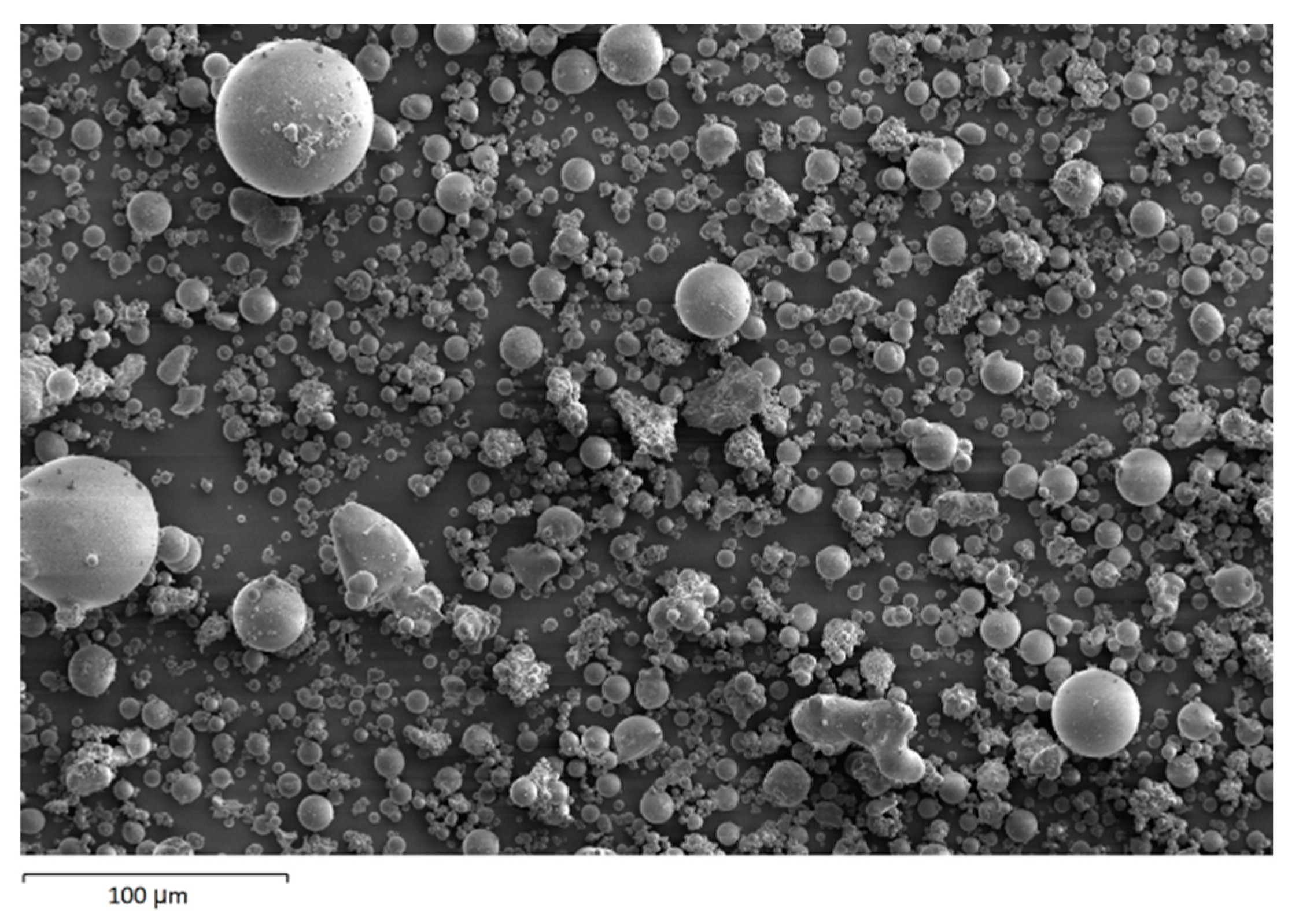
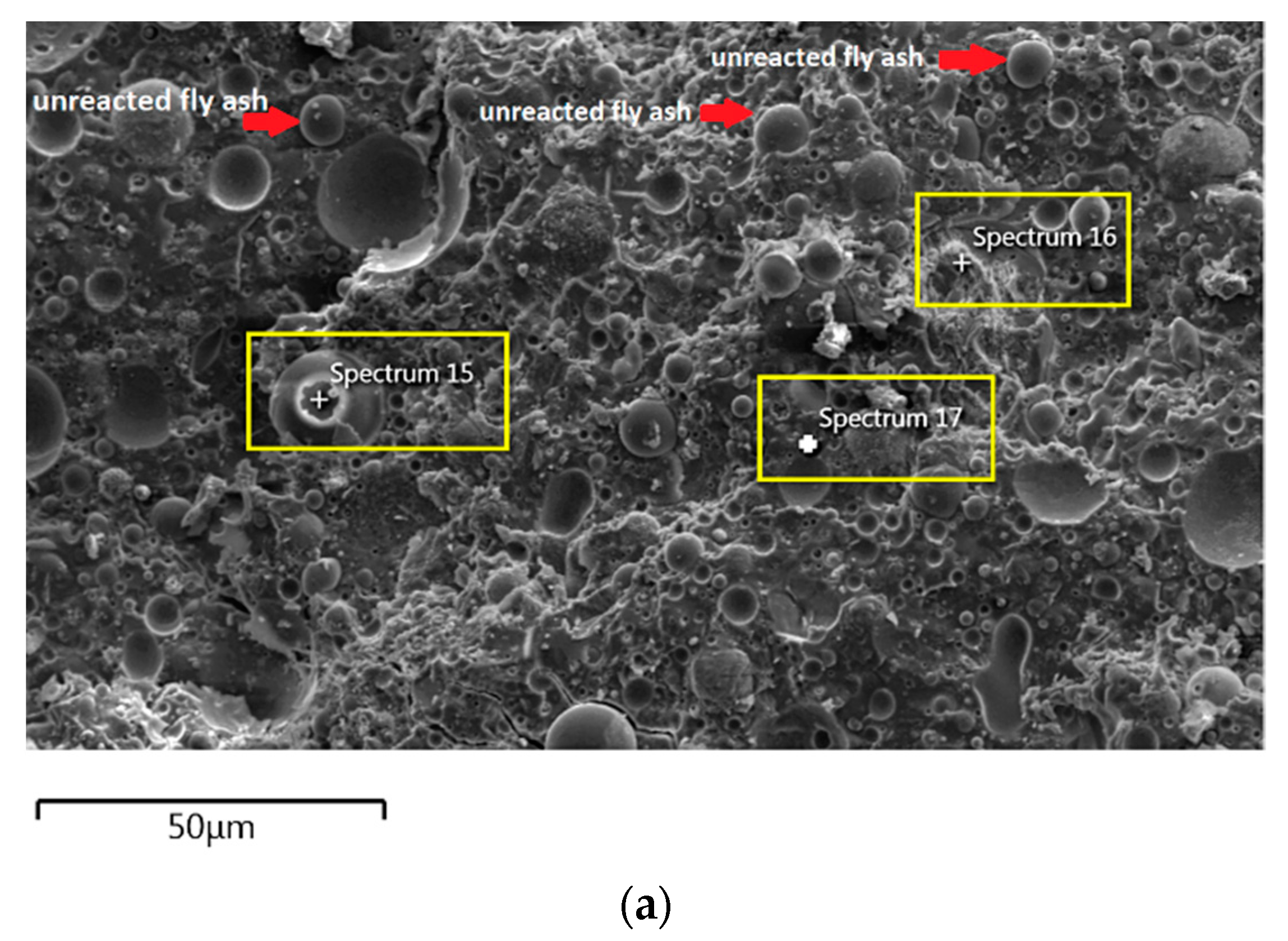




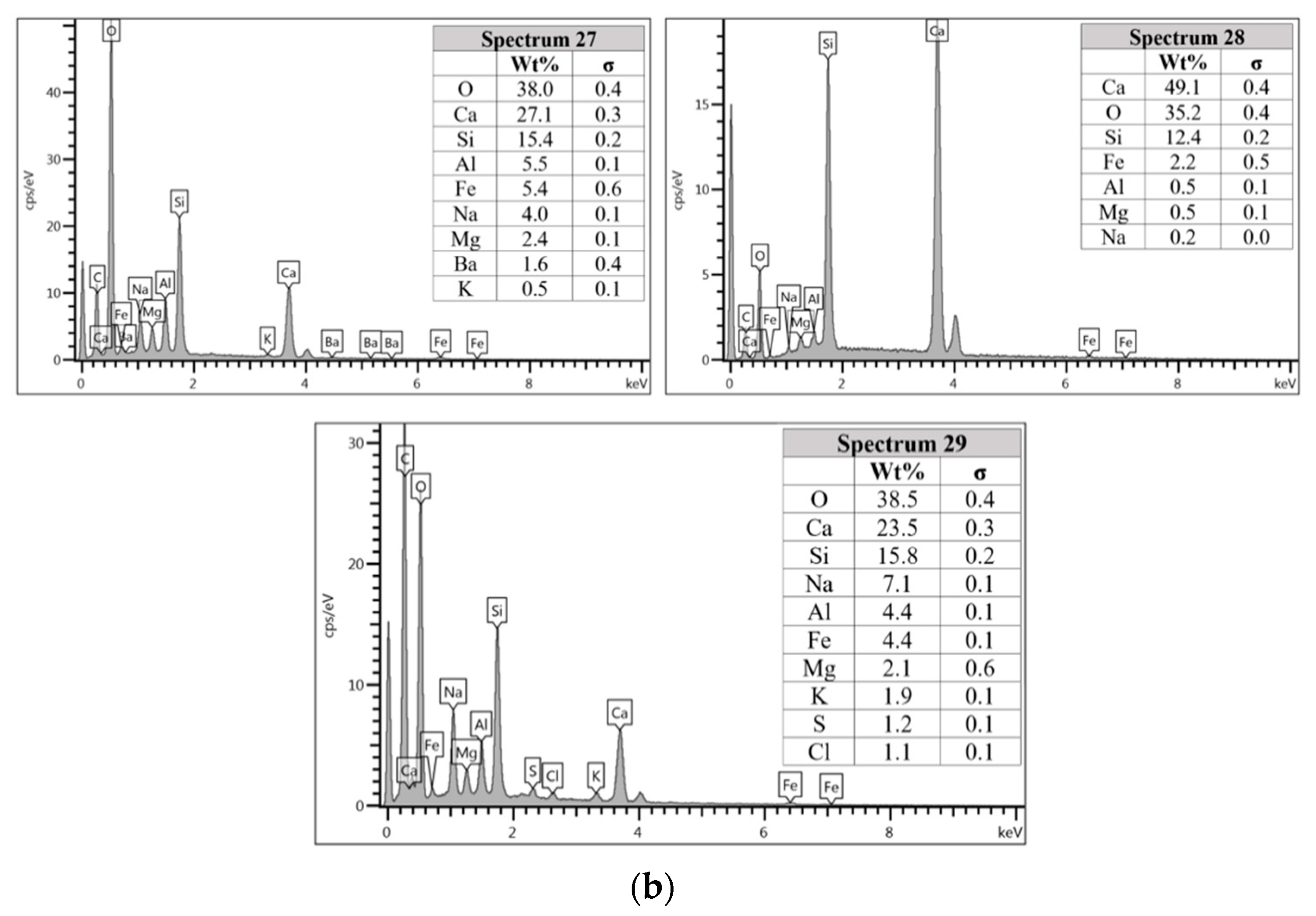

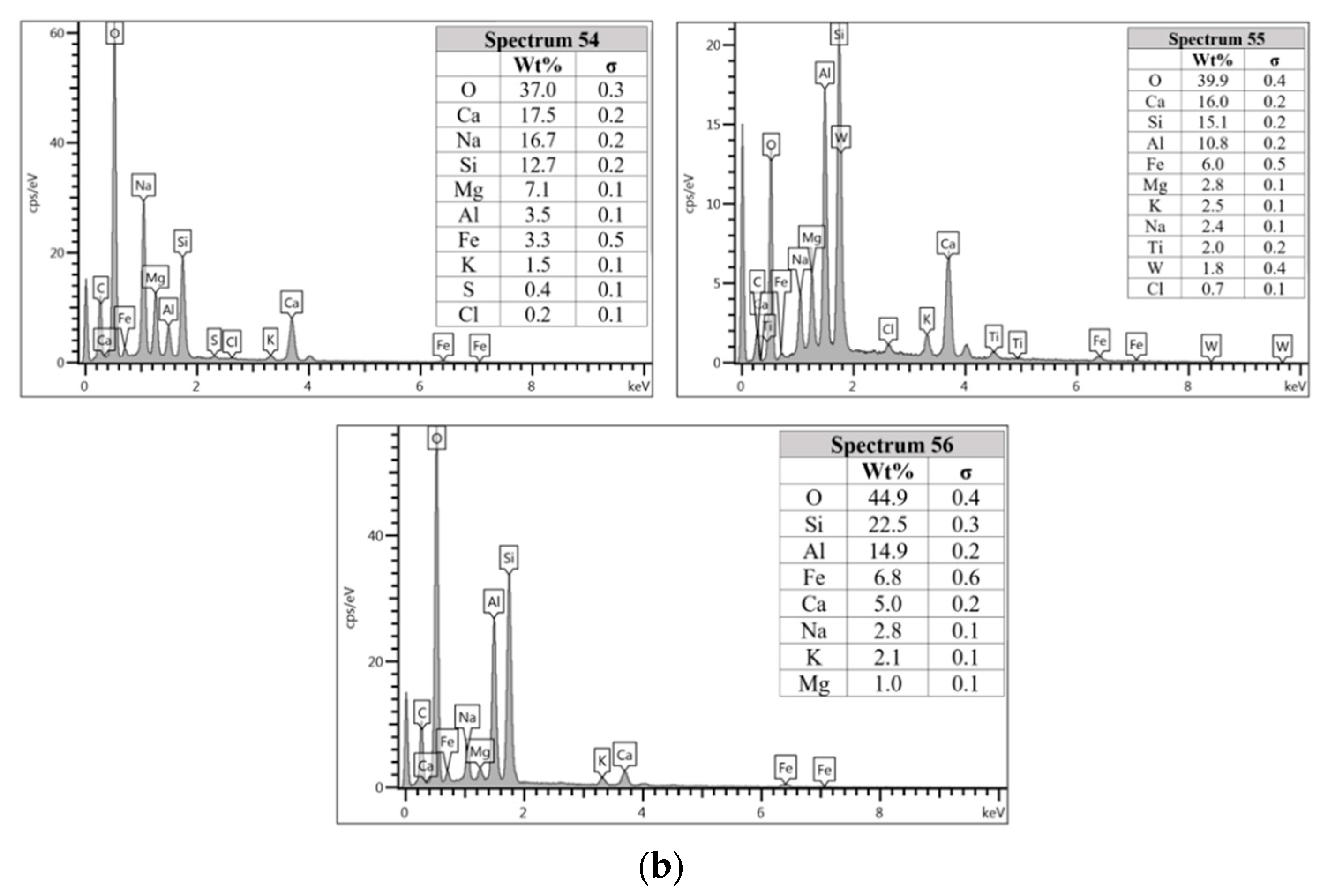
| Parameter | Indicator |
|---|---|
| Ratio fly ash/alkaline activator | 2 |
| Ratio waterglass/NaOH | 2.5 |
| Mass of fly ash (wt.%) | 66.7 |
| Mass of NaOH solution (wt.%) | 9.6 |
| Mass of sodium silicate solution (wt.%) | 23.8 |
| Types of Water | Setting Times (minutes) | |
|---|---|---|
| Initial | Final | |
| Dry Condition | 31 ± 0.5 | 40 ± 0.5 |
| Seawater | 26 ± 0.5 | 35 ± 0.5 |
| River Water | 30 ± 0.5 | 37 ± 0.5 |
| Lake Water | 28 ± 0.5 | 35 ± 0.5 |
| AAFA Paste (wt. %) | |||||
|---|---|---|---|---|---|
| Composition | Fly Ash | Dry Condition | Seawater | River Water | Lake Water |
| SiO2 | 30.80 | 34.30 | 34.60 | 34.20 | 34.00 |
| Al2O3 | 13.10 | 10.60 | 10.80 | 10.70 | 10.70 |
| CaO | 22.30 | 21.50 | 22.00 | 21.20 | 21.20 |
| Fe2O3 | 22.99 | 24.75 | 24.38 | 23.64 | 23.47 |
| MgO | 4.00 | 3.10 | 3.10 | 3.00 | 3.20 |
| TiO2 | 0.89 | 0.94 | 0.93 | 0.88 | 0.88 |
| K2O | 1.60 | 1.43 | 1.42 | 1.30 | 1.33 |
| SO3 | 2.67 | 2.02 | 1.20 | 0.93 | 0.91 |
| MnO | 0.21 | 0.22 | 0.22 | 0.21 | 0.20 |
| Si/Al ratio | 2.35 | 3.24 | 3.20 | 3.20 | 3.18 |
| Ca/Si ratio | 0.72 | 0.63 | 0.64 | 0.62 | 0.62 |
| Fe/Si ratio | 0.75 | 0.72 | 0.70 | 0.69 | 0.69 |
| Strength (MPa) | - | 80.9 | 71.1 | 63.7 | 69.5 |
Publisher’s Note: MDPI stays neutral with regard to jurisdictional claims in published maps and institutional affiliations. |
© 2021 by the authors. Licensee MDPI, Basel, Switzerland. This article is an open access article distributed under the terms and conditions of the Creative Commons Attribution (CC BY) license (https://creativecommons.org/licenses/by/4.0/).
Share and Cite
Yahya, Z.; Abdullah, M.M.A.B.; Li, L.-y.; Burduhos Nergis, D.D.; Hakimi, M.A.A.Z.; Sandu, A.V.; Vizureanu, P.; Razak, R.A. Behavior of Alkali-Activated Fly Ash through Underwater Placement. Materials 2021, 14, 6865. https://doi.org/10.3390/ma14226865
Yahya Z, Abdullah MMAB, Li L-y, Burduhos Nergis DD, Hakimi MAAZ, Sandu AV, Vizureanu P, Razak RA. Behavior of Alkali-Activated Fly Ash through Underwater Placement. Materials. 2021; 14(22):6865. https://doi.org/10.3390/ma14226865
Chicago/Turabian StyleYahya, Zarina, Mohd Mustafa Al Bakri Abdullah, Long-yuan Li, Dumitru Doru Burduhos Nergis, Muhammad Aiman Asyraf Zainal Hakimi, Andrei Victor Sandu, Petrica Vizureanu, and Rafiza Abd Razak. 2021. "Behavior of Alkali-Activated Fly Ash through Underwater Placement" Materials 14, no. 22: 6865. https://doi.org/10.3390/ma14226865
APA StyleYahya, Z., Abdullah, M. M. A. B., Li, L.-y., Burduhos Nergis, D. D., Hakimi, M. A. A. Z., Sandu, A. V., Vizureanu, P., & Razak, R. A. (2021). Behavior of Alkali-Activated Fly Ash through Underwater Placement. Materials, 14(22), 6865. https://doi.org/10.3390/ma14226865










